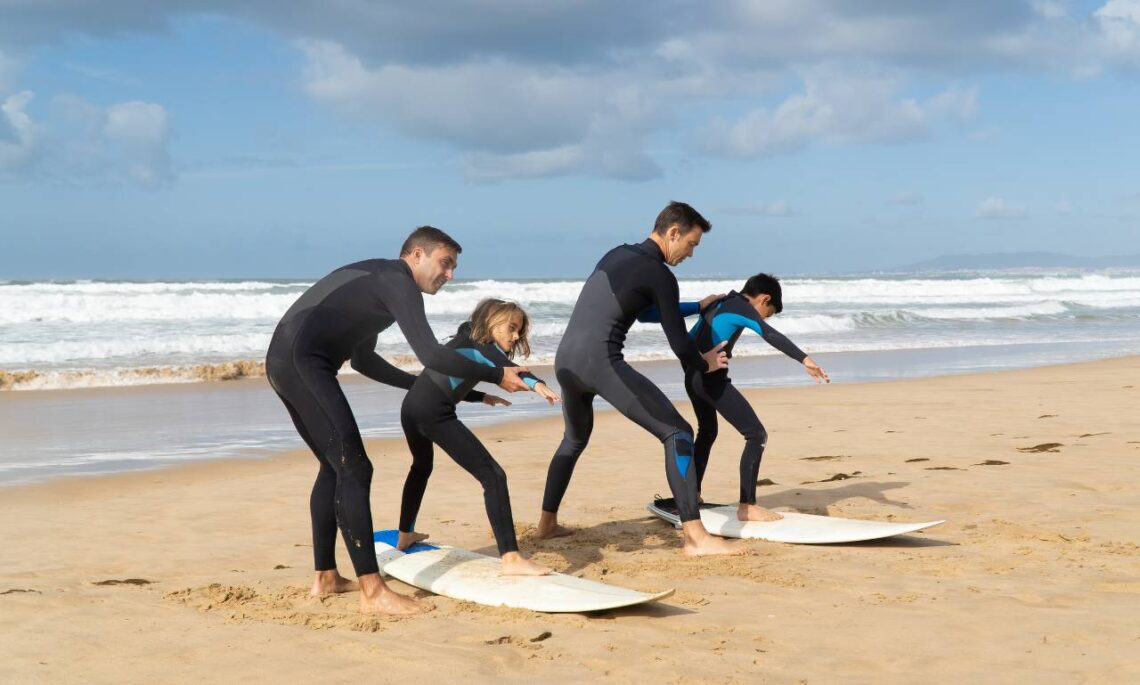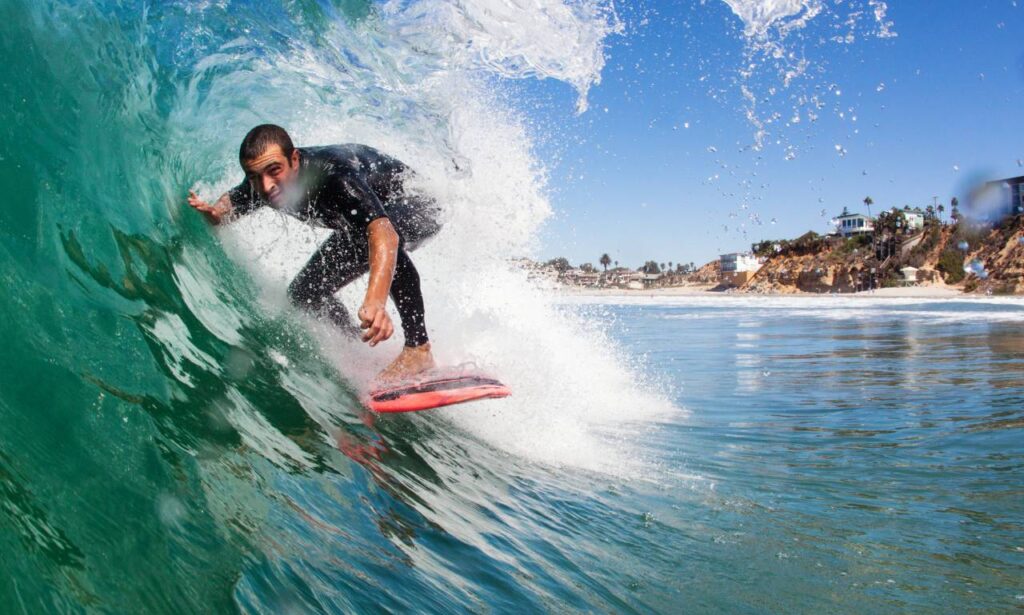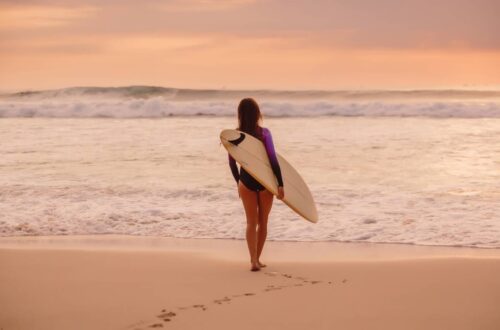
How long does it take to learn to surf ?
Ever gazed upon the horizon, watching someone glide effortlessly over the ocean waves, and felt a pang of envy? Thought to yourself, “Man, I wish that were me, feeling the breeze and owning the sea!”? Well, get ready to embark on an adventure, as we’re plunging headfirst into the thrilling, occasionally splashy, universe of surfing. 🌊
Introduction: Riding the Dream
Surfing, at its heart, transcends being merely a sport. It’s a harmonious dance with the unpredictable rhythms of the ocean. Now, I can sense you’re itching to know – just how soon can you be that person elegantly jiving with the waves? Patience, young grasshopper! Your wave is just around the corner.
The Quick Scoop: How Long Does It Take?
Picture this: Attempting to master cycling, not on a tranquil park path, but a continuously swaying bridge. Intense? Absolutely! That’s the essence of surfing. For some spirited souls, the art of balance on a board comes within days, while for others, it’s a few months of dedication. But here’s the silver lining – every tumble, every misstep, takes you one step closer to riding that monumental wave of your dreams.
Factors Playing Peek-a-boo with Your Progress
Think of surfing as a delectable dish. The right combination of ingredients and you’ve got a gastronomic delight! Miss out or overdo an ingredient, and well, you’re left with an unpalatable mess.
Here’s a sprinkle of elements that determine the flavor of your surfing journey:
- Fitness Level: Consider fitness your VIP pass. It might not grant immediate surfing prowess, but it dramatically cuts the learning curve.
- Swimming Skills: If you’ve been bosom buddies with swimming pools, you’re in luck! The ocean is essentially an expansive, undulating pool with a saltier attitude.
- Frequency: Dipping your toes into surfing annually? Neat! But diving into those waves regularly will see you zooming ahead, faster than a rocket-propelled tortoise.
Laying the Foundation: Surfing 101

Hold your horses, or in this case, your board! Before you challenge those towering waves, it’s essential to understand the ABCs of surfing. So here goes:
- Paddling: This isn’t a leisurely row in a tranquil pond. It’s you, acting as the paddle, against the whims of the mighty ocean. And sometimes, the ocean loves playing hard to get.
- Popping Up: Not related to your microwave’s popcorn timer! This is the swift transition from a prone position to confidently standing on your board. Master this, and you’re on your way to surfing stardom.
- Wave Timing: Imagine trying to hail a taxi in rush hour. Get the timing wrong, and you’re left waiting. Perfect the art of catching a wave at its prime, and it’s smooth sailing (or surfing)!
Gear Up: Your Trusty Steed, The Surfboard
You wouldn’t attempt a marathon in flip-flops, would you? Likewise, your choice of surfboard is crucial. Newbies, think grandeur! Large boards are your safety nets. They provide stability and generously overlook minor blunders. As you evolve, you can venture into the realm of more tailored, streamlined boards.
Learning Locations: Where to Begin?
Jumping into a lion’s den as your first daredevil act? Probably not the wisest choice. Similarly, initiate your surfing journey at beaches renowned for their mellow waves. Consider them your training grounds. Once you’ve earned your stripes, chase the monstrous waves for that adrenaline kick.
Safety First! No Jokes Here.
The ocean is as mesmerizing as it is formidable. Paying it due respect is paramount. Cultivate an acute sense of awareness, ensure you’re not getting in the way of fellow surfers, and when the waves turn fierce, know it’s alright to be a spectator.
Group vs Solo: How to Learn?
There’s wisdom in crowds, they claim. But when it’s about surfing, the ball’s in your court. Group sessions can be incredibly fun, loaded with camaraderie. On the other hand, one-on-one sessions ensure undivided attention, accelerating your growth. The decision? Wholly yours!
Commonly Asked Questions About Learning to surf?
How long does it generally take to learn to surf?
The timeline to learn to surf varies drastically among individuals due to various reasons:
- Fitness Level: Those with better physical conditioning may find it easier to handle the demands of surfing. Stamina, balance, and strength play essential roles.
- Frequency of Practice: Like any skill, the more you practice, the faster you’ll progress. Regular outings into the surf can accelerate learning.
- Quality of Instruction: With an experienced instructor, beginners can avoid forming bad habits and learn techniques faster.
- Personal Determination: Some individuals, driven by passion and determination, may learn faster due to their commitment.
- Initial Equipment: Starting with a beginner-friendly board can be more forgiving and speed up the initial stages of learning.
- Natural Conditions: Depending on where you learn, wave consistency and type can impact your learning curve. On average, a person might take several weeks to a few months of regular practice to ride smaller waves confidently. Mastery, however, is a lifelong journey.
What are the basic techniques every beginner should know?

Mastering the basics ensures a solid foundation for any surfer:
- Paddling: Before catching waves, one must reach them. Paddling effectively conserves energy and positions the surfer correctly.
- Pop-Up Technique: Transitioning from lying down to standing up is foundational. A quick, smooth pop-up is crucial for riding waves.
- Reading Waves: Recognizing surfable waves and understanding their patterns ensures you’re catching rideable waves and not just paddling endlessly.
- Balance and Stance: The position of your feet and weight distribution can dictate the quality of your ride. Proper stance ensures better control and maneuverability.
- Basic Turns: Learning to maneuver your board by leaning into turns and using your weight is essential for navigating waves.
- Duck Diving & Turtle Rolling: Techniques to get past waves when paddling out to the lineup. Duck diving is usually for shorter boards, while turtle rolling is for longboards.
- Safety Skills: Knowing how to fall, signal for help, and understanding the ocean’s currents are vital.
- Wave Etiquette: Understanding the unspoken rules in the lineup ensures a harmonious experience for everyone.
- Board Control: This includes handling your board safely to prevent injuries to oneself or others.
How do I choose the right board for a beginner?
Board choice can make a substantial difference:
- Volume & Stability: Beginners should start with boards that have more volume (thickness, width, and length). This offers more stability and buoyancy.
- Soft-top Boards: These are often recommended for beginners due to their forgiving nature. They’re less rigid, reducing the chance of injury.
- Length: A longer board (often longboards) is preferable for starters. They catch waves easier and offer more stability.
- Width: A wider board provides more balance, especially when trying to stand.
- Thickness: A thicker board offers more buoyancy, making it easier to paddle and catch waves.
- Fins: Starting with a standard three-fin (thruster) setup is good for beginners, offering a mix of control and stability.
- Board Shape: A rounded nose and tail are more forgiving and versatile for new surfers. It’s often advised to consult with a local surf shop or instructor to get personalized recommendations.
How important is physical fitness in learning to surf?
Physical fitness plays a pivotal role:
- Core Strength: Surfing requires a strong core for balance, pop-ups, and turns.
- Upper Body Strength: Paddling demands strength in the shoulders and arms.
- Stamina: Being able to paddle for longer and fight through stronger currents requires good cardiovascular health.
- Flexibility: Helps in maneuvering the board and reduces the risk of injuries.
- Leg Strength: Once upon the board, leg muscles control the ride. While peak fitness isn’t a prerequisite, being in reasonably good shape can make the learning process smoother and less strenuous.
Which are the best locations for beginners to learn surfing?
Ideal locations offer consistent, smaller waves, and a safe environment:
- Consistent Breaks: Places with consistent yet not overpowering waves like Waikiki in Hawaii or Byron Bay in Australia.
- Sandy Bottoms: Locations without a lot of rocks or coral reduce the risk of injury.
- Crowds: Less crowded spots are better for beginners to avoid collisions and pressure.
- Local Schools & Rentals: Locations with surf schools and rental facilities can make the process more structured.
- Weather & Water Conditions: Mild weather and warmer waters can make the experience more comfortable for newbies.
What is the role of tides and waves in the learning process?
Tides and waves dictate the surfing experience:
- Tidal Movements: The rise and fall of the ocean can affect wave shapes, sizes, and power. Some breaks are best at high tide, others at low.
- Wave Size & Power: Beginners usually benefit from smaller, less powerful waves, which offer a less intimidating environment.
- Understanding Breaks: Some breaks are mellow and roll gently, ideal for beginners. Others might be steep or dump quickly, better suited for experienced surfers.
- Currents & Rips: Recognizing and understanding how to navigate these is crucial for safety and positioning in the lineup.
- Wave Forecasting: Using tools like Surfline or Magic Seaweed can help surfers understand conditions and plan their sessions.
How do I know if I’m ready for bigger waves?
Graduating to larger waves requires self-assessment and certain cues:
- Confidence in Smaller Waves: Mastery over smaller waves, including catching them consistently, and controlling rides.
- Paddling Skills: Being able to paddle efficiently against stronger currents is essential.
- Duck Diving & Turtle Rolling: Successfully navigating past larger waves to get to the lineup.
- Physical Fitness: Greater wave size demands more physical exertion.
- Mental Preparedness: Accepting the increased risks and staying calm in challenging situations.
- Feedback: Taking feedback from experienced surfers or instructors can be invaluable.
What are the safety precautions I need to consider?
Safety should always be a priority:
- Swimming Ability: Being a strong swimmer is foundational.
- Leash: Always have your board attached to you with a leash.
- Falling Techniques: Knowing how to fall to minimize injury risk is essential.
- Understanding Currents: Recognizing rip currents and knowing how to escape them can be life-saving.
- Weather & Ocean Conditions: Avoiding days with storm warnings or extremely choppy waters.
- Sun Protection: Using sunblock and wearing appropriate attire like rash guards can prevent sunburns.
- Hydration: Always stay hydrated, especially during longer sessions.
- Buddy System: Never surf alone. Having someone with you can be invaluable in emergencies.
Is it better to learn with a group or get private lessons?
This depends on personal preference:
- Group Lessons: Can be more fun and social. Watching peers can also be educational. However, the instructor’s attention is divided.
- Private Lessons: Offer one-on-one attention, ensuring personalized feedback and quicker progress. They might be more expensive, but the tailored experience can be worth it. The best choice often depends on the individual’s learning style and budget.
What should I know about sharks when learning to surf?
Sharks are a part of the ocean ecosystem, but a few things can ease concerns:
Statistics: The chance of a shark encounter is extremely low. Other risks, like drowning or injuries from the board, are more prevalent.
Time of Day: Sharks are more active during dawn and dusk. It’s advisable to avoid surfing during these times.
Avoiding Baitfish: Schools of baitfish can attract predators. It’s best not to surf in areas where they’re present.
Injuries & Blood: Avoid entering the water with open cuts or wounds.
Shark Behavior: Most species are not aggressive towards humans. Understanding their behavior can ease fears.
Safety Measures: Some regions offer shark nets or have surveillance methods in place.
Awareness: Always be observant of your surroundings and heed any warnings or signs.
Remember, the ocean is their home. Respect and awareness are key.
In a Nutshell…
Learning to surf is like riding a roller coaster. There are ups and downs, thrills and spills. But oh boy, once you get the hang of it, the ride’s worth every twist and turn. So, how long does it take to learn to surf? It varies. But with passion, patience, and a sprinkle of grit, you’ll be shredding waves in no time.
There you have it! Now, go out there, grab a board, and make some waves! Remember, the best surfer out there is the one having the most fun. 🤙🌊

